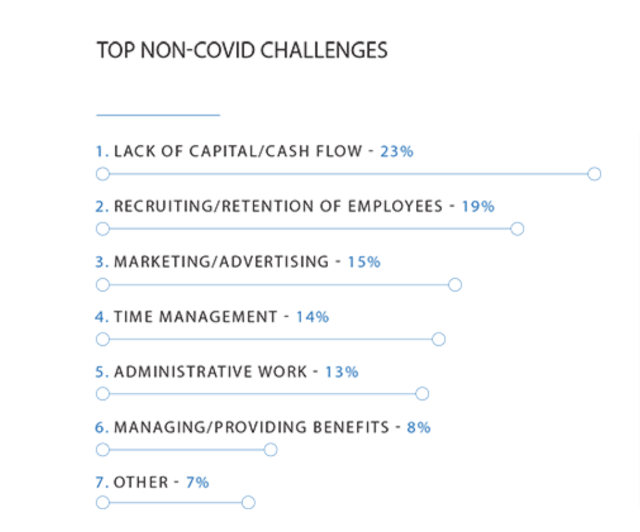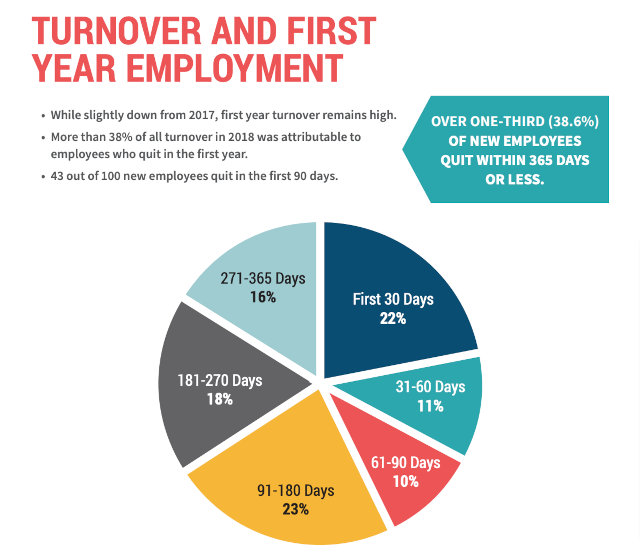Did you know that one in 12 businesses closes every year?
In addition, only about 33% of the businesses survive for more than 10 years after their inception.
This is mainly because of the challenges that small businesses face in their initial years. While some businesses take these hurdles as an opportunity to improve and learn from, others fade away.

That said, here are the five most common challenges that most small businesses go through and the strategies to overcome them.
1. Capital and Cash Flow Constraints
Any business — small or big — needs initial capital to start off and working capital to operate steadily.
According to a survey, 23% of the 2400 small business owners said that lack of capital and cash flow is their number one business challenge.

Apparently, lack of capital and cash flow constraint is a major problem for any small business. It not only hampers the growth and innovation, but also negatively impacts the day-to-day operational efficiency and quality.
Solution:
- Small business loan: Many banks and financial institutions provide funding to small businesses. However, the approval depends on your requirement and ability to repay the loan.
- Small business grants: Unlike loans, a business grant is an interest free option to fund your small business. Many public and private business entities as well as governments provide such financing facilities to help small businesses recover from crises.
- Crowdfunding: Another way to fund your business is by raising money from a large number of people online. You can use platforms like Kickstarter or Indiegogo to raise funds online.
- Venture capital funding: Look for individual investors or venture capital firms that would like to invest in your business against equity or stake in your business.
- Family and friends: If none of the above works, you can also consider borrowing from your family and friends to keep your business afloat.
Moreover, to increase your chances of securing funds through loan, grant, crowdfunding, venture capital, etc., ensure you have a business plan with earning projections when you pitch them.
2. Building a Customer Base
Unless you’re a reputed brand in your niche, you need to get out there and look for customers. In fact, even the most successful and reputed companies also have to keep building and expanding their customer base consistently.
However, let’s admit it. This challenge is much more significant for small businesses because:
- You’re still not a household name, so customers don’t recognise your brand well.
- Customer acquisition costs (CAC) have nearly increased by 55% over the last five years.
- Limited financial resources don’t allow you to spend enough on marketing and advertising.
Above factors make customer acquisition even more difficult for small businesses.
Solution:
- Know your audience: Before you can attract customers, you need to know them well (like really well!). Creating a buyer persona is a good place to start knowing the likes, dislikes, goals, challenges, fear, etc. of your target audience. Once you know these details, you’re in a much better position to offer solutions through your products or services.
- Focus on retention: Studies show that acquiring a new customer costs five times more than retaining an existing one. So ensure you offer exceptional customer service and earn their loyalty for a long time.

- Leverage social media: Social platforms are the place where you can reach out to maximum potential customers and that too cost-effectively. Hence, make sure you create fresh content, engage with your audience, and establish your brand presence on social media platforms.
3. Talent Acquisition and Retention
Small businesses don’t only struggle to acquire customers. They also have a hard time attracting the right talent to work for them.
Again, your brand name plays a role here. It’s easier for successful brands to attract the top talent and retain them for a longer period. As a matter of fact, 75% of the job seekers prefer applying to companies that manage their brand name well.
In addition to recruitment challenges, retaining the competent employees is another problem small businesses face. As per Work Institute’s employee retention and turnover report, nearly 43% of the new employees quit in the first 90 days.

Solution:
- Invest in employer branding: Just like you create your brand for marketing to your customers, manage your employer brand to attract and retain top talent in your industry.
- Offer attractive compensation, benefits, and career growth plans to your employees to retain them for a longer period.
- Get involved: Find ways to empower your employees and get involved in their individual career goals to better understand their requirements. Accordingly, personalise their career roadmap, learning and development, etc.
4. Workflow Management
Up next is the challenge that you face as you scale up your small business.
With growing client base and team size, workflow starts becoming more dynamic in nature. Moreover, lack of systems and processes makes the daily operations unstandardized and chaotic.
Solution:
- Process documentation: A detailed process documentation is the first step towards taking control of your workflow management. Document every detail regarding workflow and processes so that all team members including the new joinees can be aligned easily.
- Invest in workflow automation tools.
- Audit your workflow processes and system regularly. Find the gaps and improvise accordingly.
5. Dependence on Founder
In absence of well defined processes and systems, most small businesses depend heavily on their founders.
Here’s a quick check:
If you’re away from your business for sometime, does it still run as efficiently as it does in your presence?
Moreover, some founders struggle to give control and decision-making autonomy to their team. They simply can’t delegate responsibilities and let the team take care of them.
Solution:
- Build a management team: Build a team of key people within your organization. Pick the ones based on their passion, performance, and knowledge of your industry.
- Learn the art of delegation: Only hiring the right employees is not going to get the work done. Learn how to delegate the work and empower your team so that they operate without your supervision.
- Succession planning: Almost all the founders of the highly successful companies plan for their own replacement while they’re operating at their best. The goal is to prepare the future leaders as you continue to grow your business.
Final Thoughts
Now that we have discussed some of the most common obstacles that small businesses face, it’s time to review the challenges within your organization.
If you’re also going through some of the challenges mentioned above, try the solutions and see if they work right for your business.
Additionally, don’t hesitate to consult experts or mentors if you find yourself dealing with the same business problems for too long.
About the Author:
Hazel Raoult is a freelance marketing writer and works with PRmention. She has 6+ years of experience in writing about business, entrepreneurship, marketing and all things SaaS. Hazel loves to split her time between writing, editing, and hanging out with her family.




